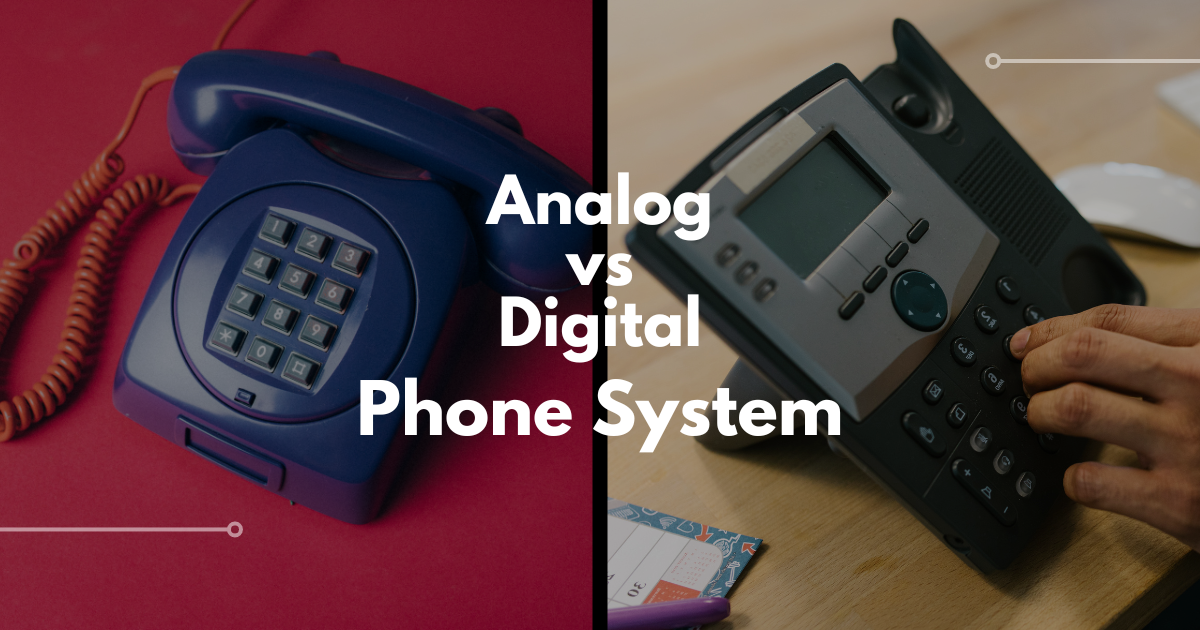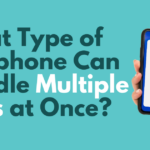The decision between analog and digital phone system can be a pivotal one for businesses. At Wondercomm, we understand the importance of making informed choices in this fast-paced digital age.
In this blog post, we embark on a journey to unravel the intricacies of analog and digital phone systems, aiming to provide clarity for businesses seeking the most suitable solution for their communication needs. Whether you’re a small startup looking to establish your first phone system or a seasoned enterprise considering an upgrade, the choice between analog and digital is a crucial one that can significantly impact your operations and bottom line.
Join us as we delve into the world of analog and digital phone systems, exploring their features, benefits, and the factors to consider when making this pivotal decision. By the end of this journey, you’ll be equipped with the knowledge needed to choose the right path for your phone system, ensuring seamless communication and enhanced productivity for your business.
I. Introduction
A. Brief Overview of the Importance of Choosing Between Analog and Digital Phone System
In the rapidly evolving landscape of communication technology, the choice between analog and digital phone systems holds significant weight for businesses of all sizes. While analog systems have long been the traditional choice, digital systems have surged in popularity, offering a myriad of features and benefits tailored to modern business needs.
The decision to opt for either an analog or digital phone system can impact various aspects of your business operations, including efficiency, scalability, and cost-effectiveness. Analog systems, characterized by their use of traditional copper lines, are known for their reliability and simplicity. However, they may lack the advanced features and flexibility that digital systems provide.
On the other hand, digital phone systems leverage internet protocols to transmit voice data, offering enhanced functionality, integration capabilities, and cost savings. With features such as voicemail-to-email, call forwarding, and remote access, digital systems empower businesses to streamline communication processes and adapt to the demands of a dynamic market landscape.
B. Introduction to the Aim of the Blog Post: Providing Clarity and Guidance for Businesses in This Decision-Making Process
In this blog post, we embark on a journey to demystify the complexities surrounding analog and digital phone systems. Our aim is to equip businesses with the knowledge and insights needed to make informed decisions that align with their unique needs and objectives.
Whether you’re a small startup navigating the realm of communication technology for the first time or a seasoned enterprise seeking to upgrade your existing phone system, the choice between analog and digital is a pivotal one. By offering clarity and guidance, we aim to empower businesses to navigate this decision-making process with confidence, ultimately enhancing their communication capabilities and driving success in an increasingly digital world.
Throughout this blog post, we’ll delve into the features, benefits, and considerations of both analog and digital phone systems, providing real-world examples and expert insights to aid you in making the right choice for your business. So, let’s embark on this journey together and uncover the path to optimal communication solutions.
II. Understanding Analog Phone Systems
A. Definition and Explanation of Analog Phone Systems
Analog phone systems, also known as Plain Old Telephone Service (POTS), are traditional telecommunication systems that transmit voice signals over copper wires. These systems have been in use for decades and are characterized by their simplicity and reliability. In an analog system, voice signals are converted into electrical signals, transmitted over the telephone network, and then converted back into audible sound at the receiving end.
B. Features and Characteristics of Analog Phone Systems
Analog phone systems offer a range of features that cater to basic communication needs. These features include:
- Voice calls: Analog systems support voice calls between users connected to the same telephone network.
- Call waiting: Users are notified of incoming calls while on a call and can switch between calls.
- Caller ID: Displays the phone number of the incoming call, if available.
- Voicemail: Allows users to receive and store voice messages when they are unable to answer a call.
Analog phone systems are known for their reliability, as they are less susceptible to interference and outages compared to digital systems. Additionally, analog systems are easy to install and maintain, making them a cost-effective option for businesses with basic communication needs.
C. Pros and Cons of Analog Phone Systems
Pros:
- Reliability: Analog systems are known for their reliability, making them suitable for businesses that require consistent communication.
- Compatibility: Analog systems are compatible with most telecommunication devices, including fax machines and modems.
- Cost-effective: Analog systems are generally less expensive to install and maintain compared to digital systems.
Cons:
- Limited features: Analog systems offer limited features compared to digital systems, such as call forwarding, voicemail-to-email, and conference calling.
- Limited scalability: Analog systems may be less scalable than digital systems, making it challenging to expand the system as your business grows.
- Quality: Analog systems may experience voice quality degradation over long distances or in areas with poor line quality.
D. Real-World Examples or Case Studies Illustrating the Use of Analog Phone Systems
One example of a business that relies on analog phone systems is a small retail store. The store uses analog phones for internal communication between employees and for receiving customer inquiries. The simplicity and reliability of analog systems make them an ideal choice for businesses that require basic communication capabilities without the need for advanced features.
In another example, a rural community may rely on analog phone systems for communication due to limited access to digital infrastructure. Analog systems provide a reliable means of communication for residents in remote areas where digital services may be unavailable or unreliable.
III. Unveiling Digital Phone Systems
A. Definition and Explanation of Digital Phone System
Digital phone systems, also known as Voice over Internet Protocol (VoIP) systems, use internet protocols to transmit voice data over the internet. Unlike analog systems, which rely on traditional copper wires, digital phone systems convert voice signals into digital data packets, which are then transmitted over the internet and converted back into audible sound at the receiving end.
B. Features and Characteristics of Digital Phone System
Digital phone systems offer a wide range of features that enhance communication and collaboration within businesses. These features include:
- Scalability: Digital phone systems are highly scalable, allowing businesses to easily add or remove phone lines as needed.
- Cost-effective: Digital phone systems are often more cost-effective than analog systems, as they utilize existing internet infrastructure and require minimal hardware.
- Advanced features: Digital phone systems offer advanced features such as voicemail-to-email, call forwarding, auto-attendant, and conference calling.
- Integration: Digital phone systems can integrate with other business applications, such as customer relationship management (CRM) software, to streamline communication processes.
C. Pros and Cons of Digital Phone Systems
Pros:
- Cost-effective: Digital phone systems are often more cost-effective than analog systems, as they utilize existing internet infrastructure.
- Advanced features: Digital phone systems offer advanced features that enhance communication and collaboration within businesses.
- Scalability: Digital phone systems are highly scalable, allowing businesses to easily add or remove phone lines as needed.
Cons:
- Dependence on internet connection: Digital phone systems rely on a stable internet connection, so businesses in areas with poor internet connectivity may experience issues.
- Voice quality: The quality of voice calls on digital phone systems can be affected by internet bandwidth and network congestion.
- Security concerns: Digital phone systems are susceptible to cyber threats, so businesses must implement security measures to protect their communication data.
D. Real-World Examples or Case Studies Illustrating the Use of Digital Phone Systems
One example of a business that utilizes digital phone systems is a remote team of customer service representatives. The team uses digital phones to communicate with customers over the internet, allowing them to provide efficient and effective customer service from any location.
In another example, a growing startup may choose to implement a digital phone system to accommodate its expanding workforce. The scalability and cost-effectiveness of digital phone systems make them an ideal choice for businesses that are looking to grow and evolve their communication infrastructure.
IV. Key Considerations When Choosing Between Analog and Digital Phone System
A. Business Needs and Requirements
One of the first considerations when choosing between analog and digital phone systems is understanding your business’s unique needs and requirements. Consider the size of your business, the number of employees, and the nature of your communication needs. For example, a small business with minimal communication requirements may find an analog system sufficient, while a larger enterprise with more complex communication needs may benefit from the advanced features of a digital system.
B. Scalability and Flexibility
Scalability and flexibility are crucial factors to consider when choosing a phone system. Digital phone systems are highly scalable, allowing businesses to easily add or remove phone lines as needed. Additionally, digital systems offer greater flexibility in terms of features and functionality, allowing businesses to tailor their phone system to meet their specific requirements.
C. Cost Analysis: Initial Investment and Long-Term Expenses
Cost is a significant consideration when choosing between analog and digital phone systems. While analog systems may have a lower initial investment cost, digital systems often prove to be more cost-effective in the long run. Consider factors such as installation costs, monthly service fees, and maintenance expenses when conducting a cost analysis.
D. Integration with Existing Infrastructure and Technologies
When choosing a phone system, it’s essential to consider how well it will integrate with your existing infrastructure and technologies. Digital phone systems offer greater integration capabilities, allowing businesses to integrate their phone system with other business applications, such as CRM software, to streamline communication processes.
E. Reliability and Quality of Service
Reliability and quality of service are critical factors to consider when choosing a phone system. While analog systems are known for their reliability, digital systems can also offer reliable service when implemented correctly. Consider factors such as internet bandwidth and network stability when evaluating the reliability of a digital phone system.
F. Future-Proofing Your Communication System
Future-proofing your communication system involves choosing a phone system that can adapt to the evolving needs of your business. Consider how well the phone system will support your business’s growth and expansion plans. Digital phone systems are often more future-proof than analog systems, as they offer greater scalability and flexibility.
By carefully considering these key factors, you can make an informed decision when choosing between analog and digital phone systems, ensuring that you select the solution that best meets your business’s needs and objectives.
V. Making the Decision: Which Is Right for Your Business?
A. Comparison Chart or Matrix Summarizing the Features and Considerations of Analog and Digital Phone Systems
To help you make an informed decision between analog and digital phone systems, here’s a comparison chart summarizing the key features and considerations of each:
| Feature/Consideration | Analog Phone Systems | Digital Phone Systems |
| Reliability | High | Dependent on Internet |
| Cost | Lower initial cost | Higher initial cost |
| Scalability | Limited | Highly scalable |
| Features | Basic | Advanced |
| Integration | Limited | Extensive |
| Quality of Service | Good | Dependent on Internet |
| Future-proofing | Limited | High |
B. Step-by-Step Guide to Evaluating Your Needs and Determining the Best Fit
- Assess Your Current Communication Needs: Determine the number of employees, call volume, and required features.
- Consider Your Future Growth: Think about how your communication needs may change as your business grows.
- Evaluate Your Budget: Compare the initial investment and long-term costs of analog and digital systems.
- Assess Your IT Infrastructure: Consider how well each system will integrate with your existing technologies.
- Evaluate Reliability and Quality: Assess the reliability and quality of service of both systems in your area.
- Consult with Experts: Seek advice from IT professionals or phone system providers to help you make an informed decision.
C. Expert Tips and Advice for Making an Informed Decision
- Consider Hybrid Solutions: Some businesses may benefit from a combination of analog and digital systems to meet their specific needs.
- Think About Mobility: If your business requires mobility, consider a digital phone system that offers mobile app integration.
- Consider VoIP Security: Digital phone systems are susceptible to cyber threats, so ensure you have adequate security measures in place.
- Think Long-Term: Choose a phone system that can grow and adapt with your business to avoid costly upgrades in the future.
VI. Conclusion
A. Key Points to Remember
We’ve explored the differences between analog and digital phone systems, highlighting their features, pros and cons, and real-world applications. We’ve also discussed key considerations for businesses when choosing between the two, including business needs, scalability, cost analysis, integration, reliability, and future-proofing.
B. Importance of Choosing the Right Phone System for Your Business
Choosing the right phone system is crucial for businesses, as it can impact communication efficiency, productivity, and customer satisfaction. Whether you opt for an analog or digital system depends on your unique business needs and requirements. It’s essential to evaluate these factors carefully to ensure you select the system that best meets your needs and helps you achieve your business goals.
C. Businesses Embarking on This Decision-Making Journey
Selecting a phone system for your business can seem daunting, but with the right information and guidance, you can make an informed decision that benefits your business in the long run. Consider consulting with experts, evaluating your needs thoroughly, and thinking about the future of your business to ensure you choose a system that can grow and adapt with your business. Remember, the right phone system can enhance communication, streamline operations, and contribute to the overall success of your business. So, take the time to evaluate your options carefully and choose wisely. Your business’s communication infrastructure is a critical component of its success, so make sure you invest in a system that meets your needs and helps you achieve your goals.





Leave a reply